For my next October review I will be giving a brief overview of the entire 3D Dangerous Sea Creatures Pictorial Book collection by The Access (also known as Access Toys), which was released just a couple months ago this past August 2023. I was originally going to just review the jellyfish, but was convinced to review the whole set by forum member JimoAi. There are seven figures in the set all representing ‘dangerous’ sea creatures. Latin names were not provided and for a few of them, the identifications provided below are my own. In translating the Japanese text on the back of the box, the focus is the waters around Japan, so that helped shape some of my identifications. Because I am doing a broad overview of the set, others may choose to do more in-depth reviews of individual figures as they desire. I only really wanted the crab, ray, and jellyfish, but it was easier and cheaper to buy the whole set. I ended up getting an additional new species for my collection in the sea snake as well. Figures will be presented in the order they appear on the back of the box. The names presented in bold at the start of each entry is the English name provided on the box.
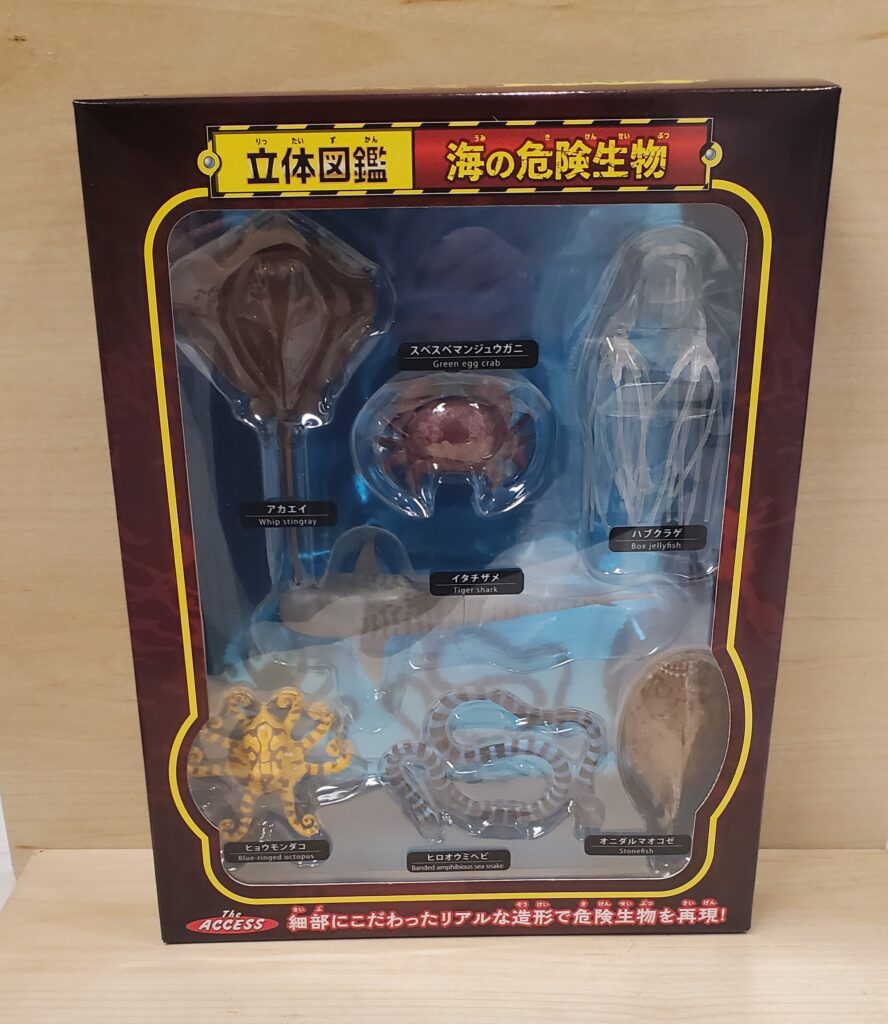
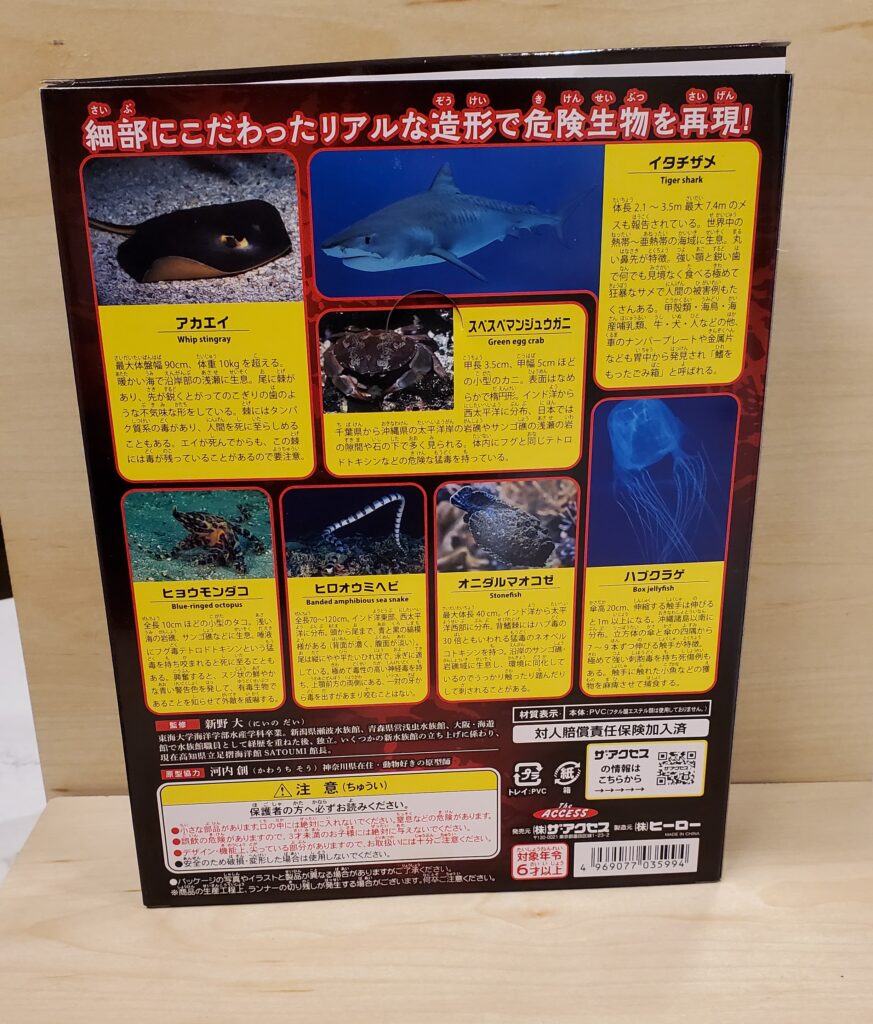
The complete collection:

Whip stingray. This figure appears to represent the red stingray (Hemitrygon akajei), and I believe earlier promotional photos for the set specifically indicated as such. Its inclusion in a set of dangerous creatures is because of its venomous tail spine, which is potentially injurious to humans. To the best of my knowledge, this is the first of its species as a toy or figure! The red stingray occurs in the Northwest Pacific around Japan, the Korean Peninsula, China, and Taiwan, with questionable records as far south as Thailand, the Philippines, and Fiji. It usually lives in sandy habitats close to the coast at depths of 10-50 meters. The figure is approximately 9.7 cm long with a width of approximately 5.4 cm, making it 1:10.3-1:20.6 in scale based on FishBase/SeaBase. It is well sculpted dorsally and ventrally; a small seam at the base of the tail suggests it was constructed from two pieces. Claspers are present, suggesting a male specimen. A stinger is sculpted on the dorsal surface near the base of the tail. Dorsally, the figure is chocolate brown with yellow eyes; ventrally, white with brown-orage margins, tail, nostrils, and gill slits. Overall, very accurate in terms of sculpt and paint, especially for its size.



Green egg crab. The identification on this one is a little more obvious, as it represents Atergatis floridus, commonly known as the floral egg crab or green egg crab. This is at least the fourth time this species has been produced. Epoch produced one for their ‘The Poison’ collection in the early 2000s and Bandai produced the species twice, in 2021 and 2022 in their Diversity of Life on Earth line, both using the same sculpt. Its inclusion in a set of dangerous sea animals is because the flesh of A. floridus is toxic, even if cooked, due to tetrodotoxin and gonyautoxin 1-4 produced by symbiotic bacteria in the genus Vibrio. Consumption of these toxins can result in death! The crab occurs on reefs in the neritic zone throughout much of the Indo-Pacific. Today’s figure has a carapace width of approximately 2.5 cm for a scale of 1:3.2-1:4.8, making the smallest figure of this species available that I am aware of. It is painted purple-red dorsally with an intricate paler pink pattern resembling lace, as seen in the actual animal.
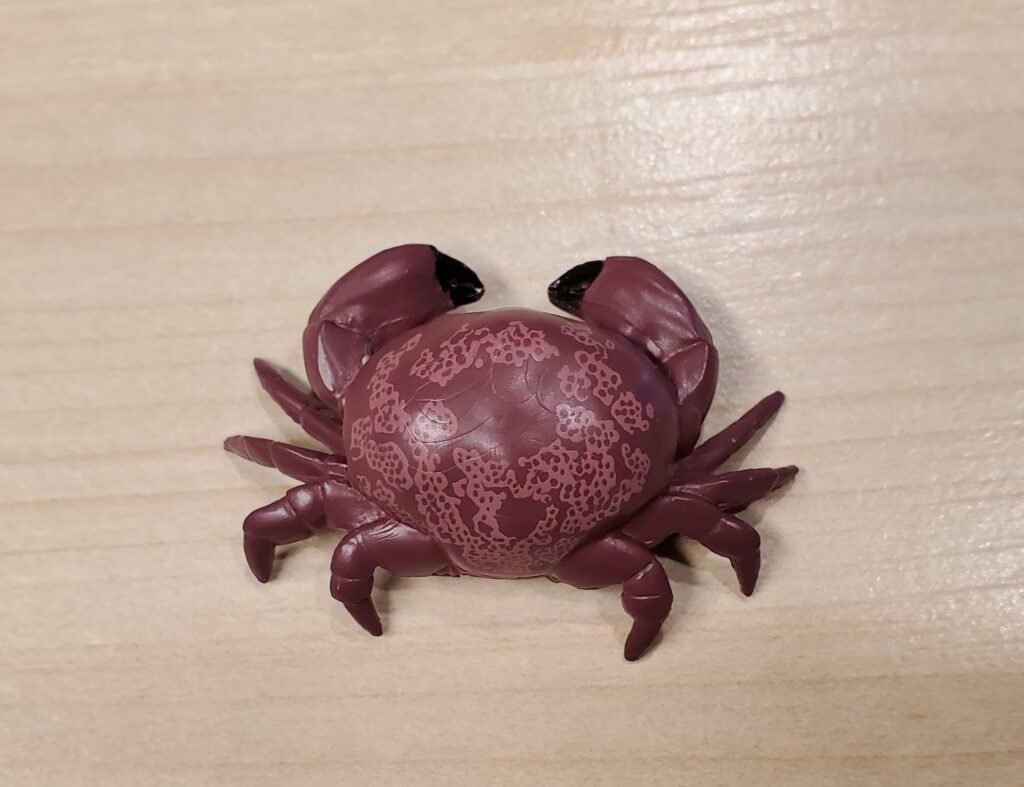


From back to front, left to right: Bandai, Epoch (with accessory fish), and The Access (sorry if the depth of field doesn’t have all three in good focus):
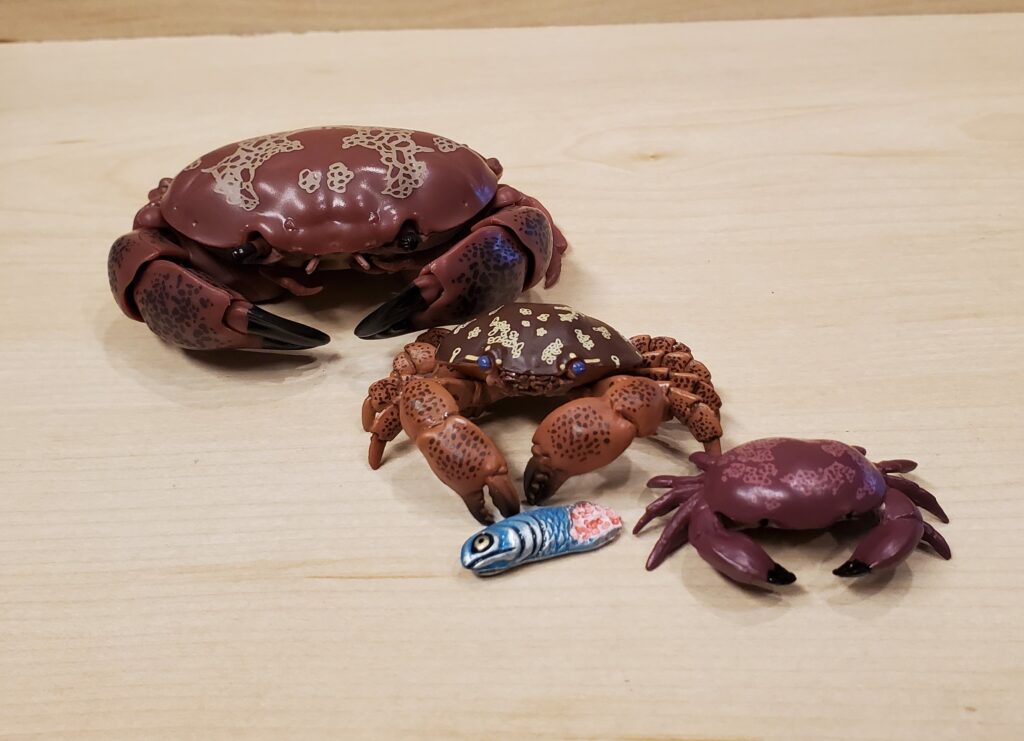
Tiger shark. This one needs little explanation, as it represents the familiar Galeocerdo cuvier. Its inclusion in a set of dangerous sea critters is because it’s considered one of the more aggressive and dangerous shark species and is responsible for a fair share of fatal shark-bite incidents. The tiger shark occurs nearly worldwide in coastal tropical and subtropical waters, usually at depths of 0-800 meters. It’s one of the more commonly made shark species, but for some reason one that many companies cannot get right, whether it be the number of gill slits, shape of body and head, or shape of the tail. Two of the better examples of this species are the Monterey Bay Aquarium figure by Safari, which is larger than most standard-sized figures, and the Kaiyodo Capsule Q Museum Yaeyama figure, which is a gashapon figure and therefore much smaller than most standard-sized figures. The tiger shark is like the Goldilocks fairy tale where we’re all looking for one that is just right. Today’s figure by The Access isn’t bad, at least in terms of shape, color, and number of gill slits. It’s missing the characteristic tail notch and there is an obvious seam mid-body suggesting it was constructed from two pieces. There are claspers, however, suggesting a male specimen. The figure measures approximately 11.3 cm for a scale of 1:26.5-1:44.2 for an average scale of 1:66.4 for a maximum-sized specimen based on SeaBase/FishBase. So, for collectors of 1:32 or 1:40 figures, this may be a good option for this species!
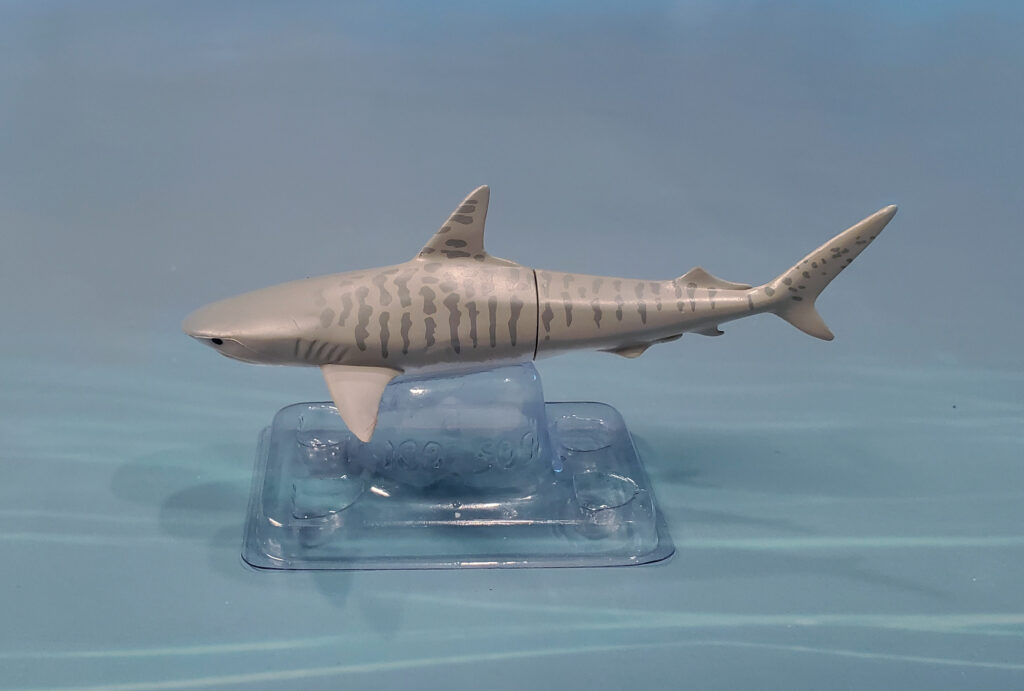

Blue-ringed octopus. The paint job on the figure is somewhat stylized, but given the presence of lines on the mantle rather than rings and the Japanese theme of the set, it was probably intended to represent the blue-lined octopus, Hapalochlaena fasciata. Also, the thumbnail pic on the back of the box illustrates H. fasciata. This species had been previously produced by Kaiyodo. The octopus occurs in shallow coral reefs, intertidal rocky shores, and tide pools in the Pacific, from Australia north to the Korean Peninsula and Japan. Hapalochlaena species are the most venomous octopi and among the most venomous animals in the world, so its inclusion in a set of dangerous sea animals seems almost guaranteed. The maximum width of the figure is approximately 5.7 cm. The mantle length is 2.4 cm for a scale of 1:1.8 (Hapalochlaena species are generally rather small). A respiratory siphon is sculpted on the animal’s left side and individual suckers are sculpted on the ventral side of each leg. There is a small bump mid-bottom at the base of all the legs which might represent a beak. The base color is a golden-yellow with blue maculae outlined in brown.
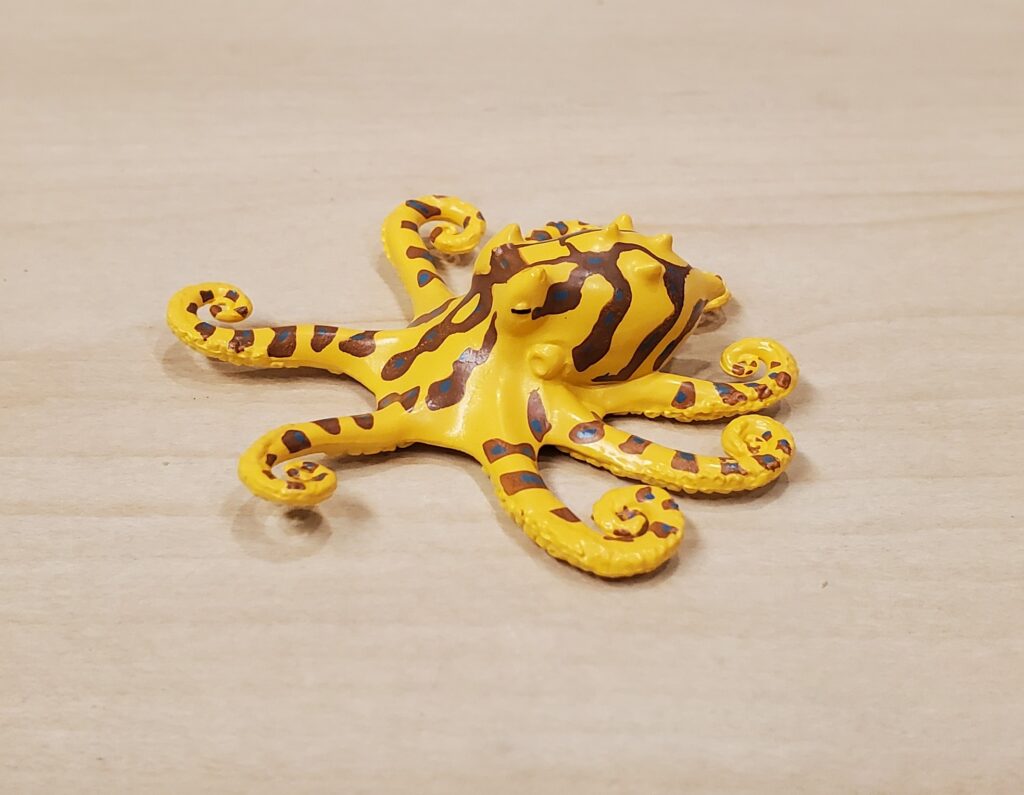

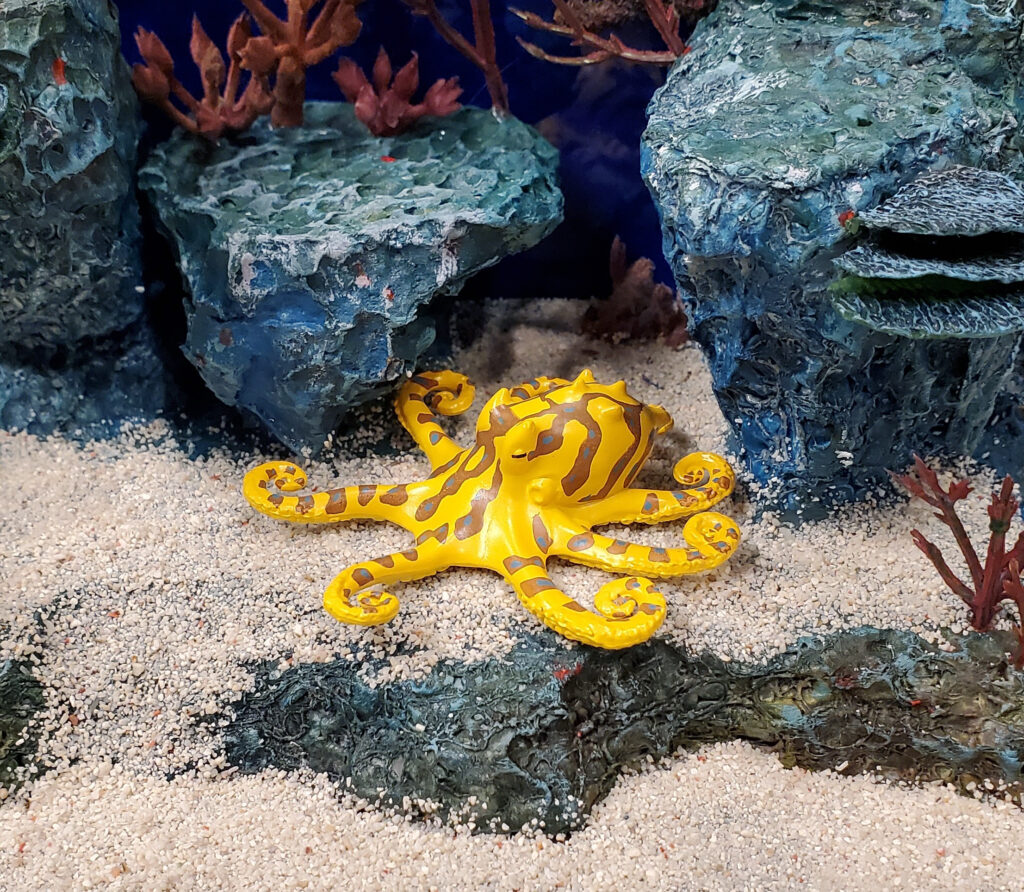
Banded amphibious sea snake. This figure appears to be a member of the genus Laticauda, and given the color and Japanese theme of the set, it probably represents either the black-banded sea krait (L. semifasciata) or the blue-lipped sea krait (L. laticaudata). For my personal collection I am databasing it as L. laticaudata as I already have a Kaiyodo figure specifically marketed as L. semifasciata (but in the end it’s the collector’s choice). The blue-lipped sea krait is found throughout much of the Indo-West Pacific in coral and rocky reefs. Like other sea snakes, L. laticaudata is highly venomous, hence its inclusion in a set of dangerous sea creatures. The maximum width of the figure is about 6.5 cm but measured along the midline the body length is approximately 24.0 cm for a scale of 1:3.8 for a male specimen of 1:4.5 for a female specimen. The dorsal surface is painted with alternating bands of black and blue while the ventral side is painted with alternating bands of black and white.
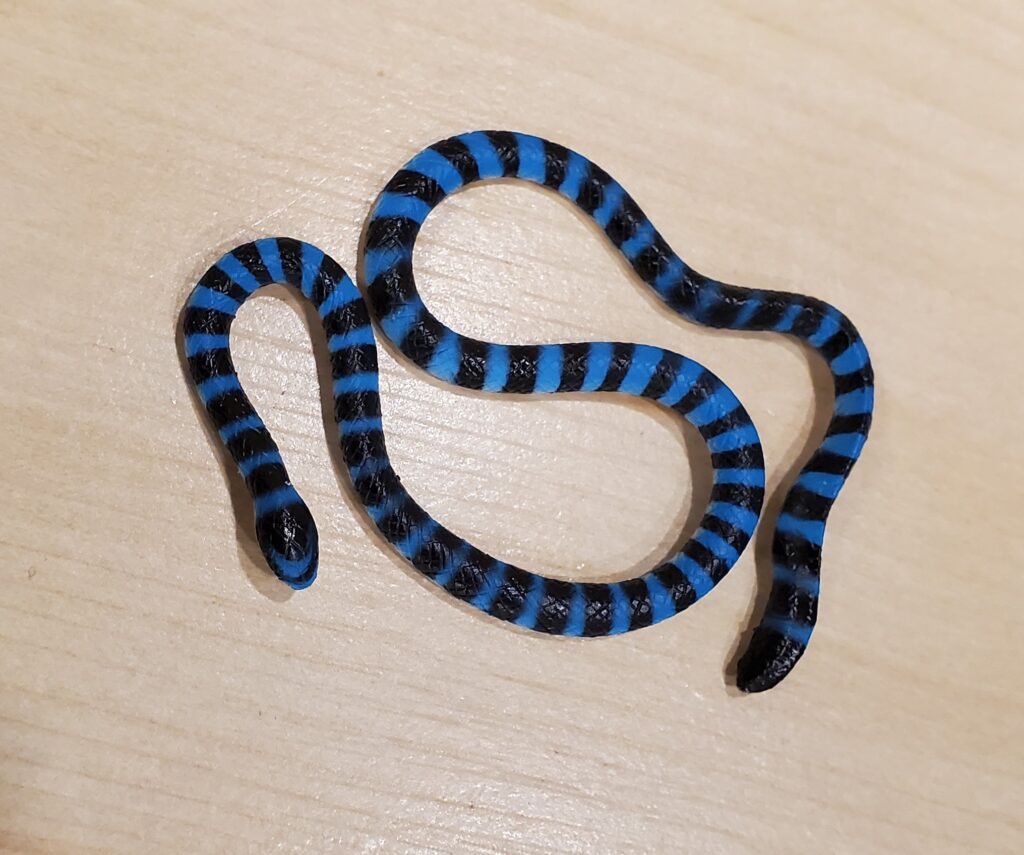

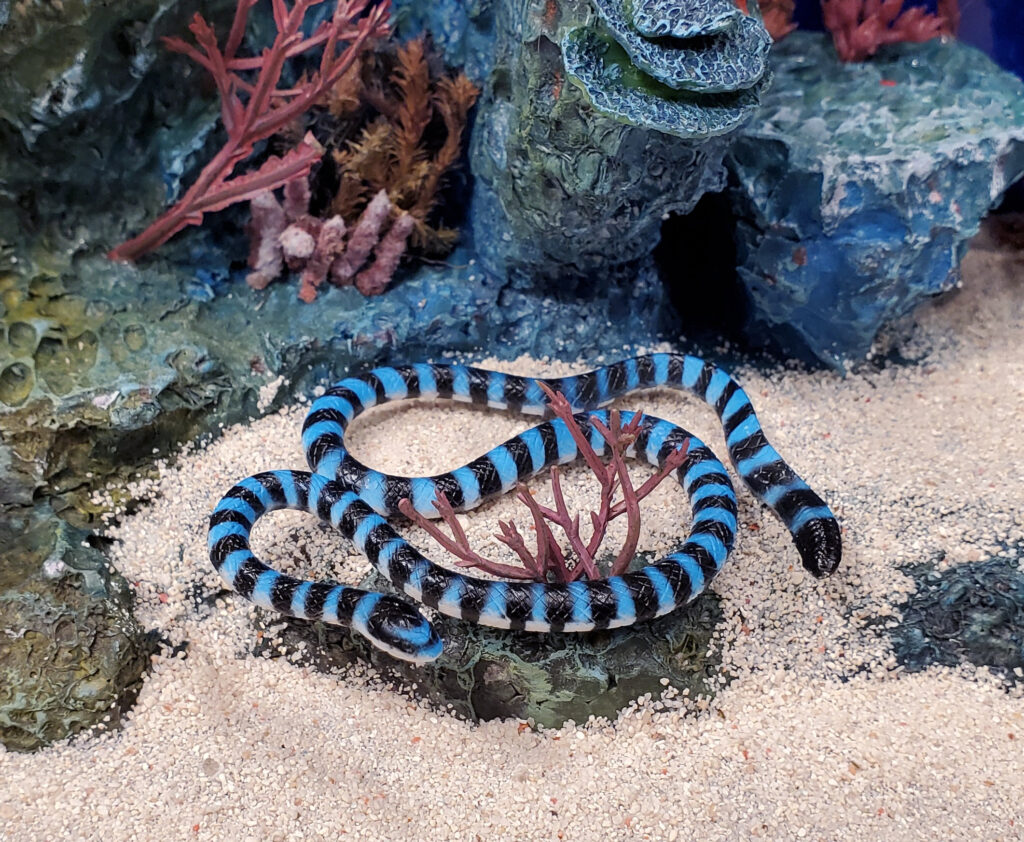
Stonefish. Based on morphology and the size mentioned on the box (40 cm), this figure represents the rock stonefish, Synanceia verrucosa. This species has been previously made by Colorata (Coral Reef Fish) and Safari Ltd. (Venomous Creatures TOOB). It is one of the deadliest fish in the sea; it possesses 13 dorsal spines that contain verrucotoxin. The fish lives in coral reefs in the Indo-West Pacific. Its recent presence in the eastern Mediterranean could be either from introductions or migrations via the Suez Canal. The figure measures just under 7.0 cm for a scale of 1:3.8-1:5.7 based on FishBase/SeaBase. It’s a solid piece of plastic with fine detail. There appears to be a couple seams suggesting it was assembled from multiple pieces. Interestingly, the seams aren’t at all obvious in-hand; I didn’t notice them until I was editing the images. The base color is a pale brown with dark brown, orange, and cream highlights.
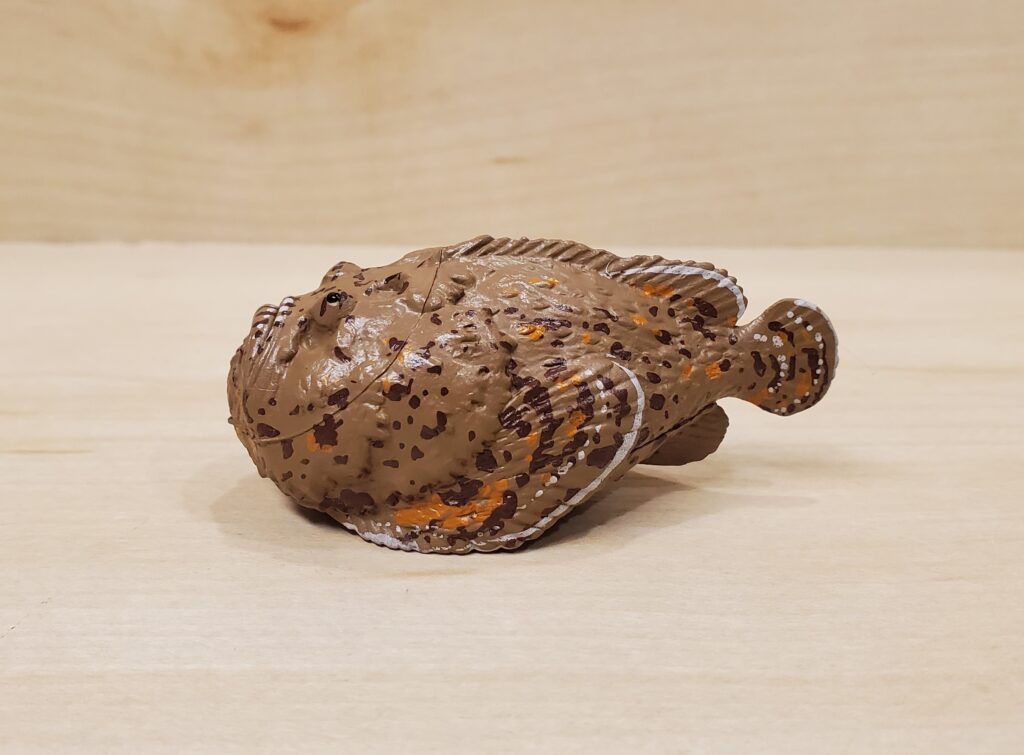
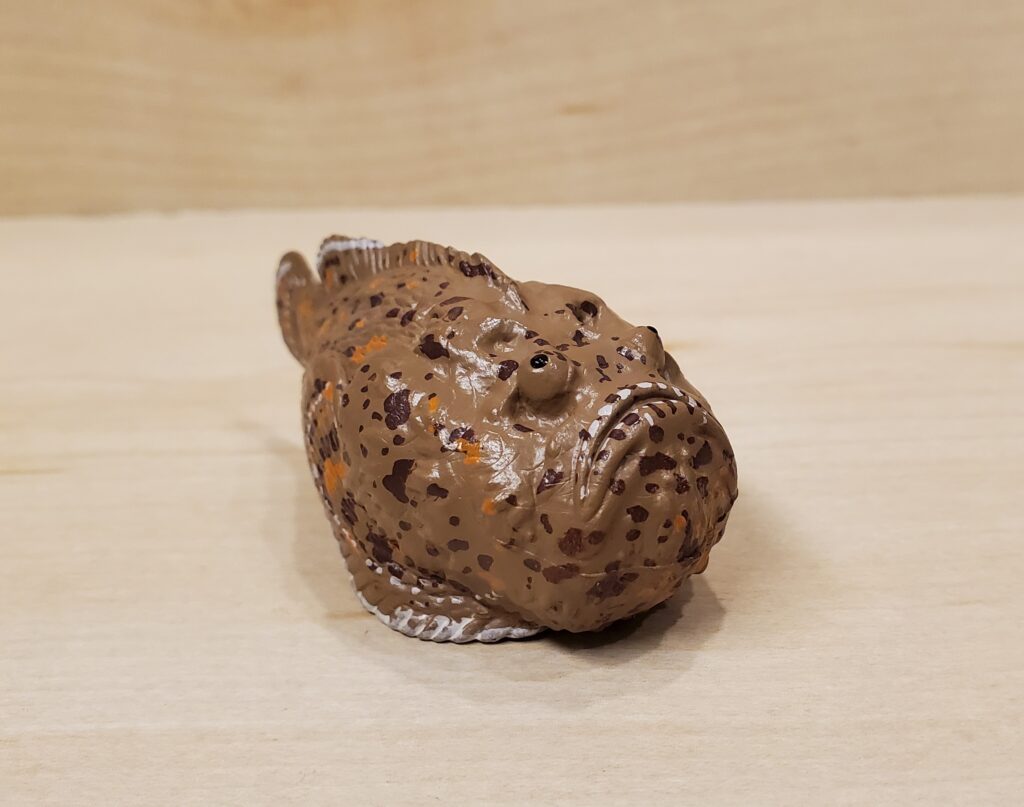
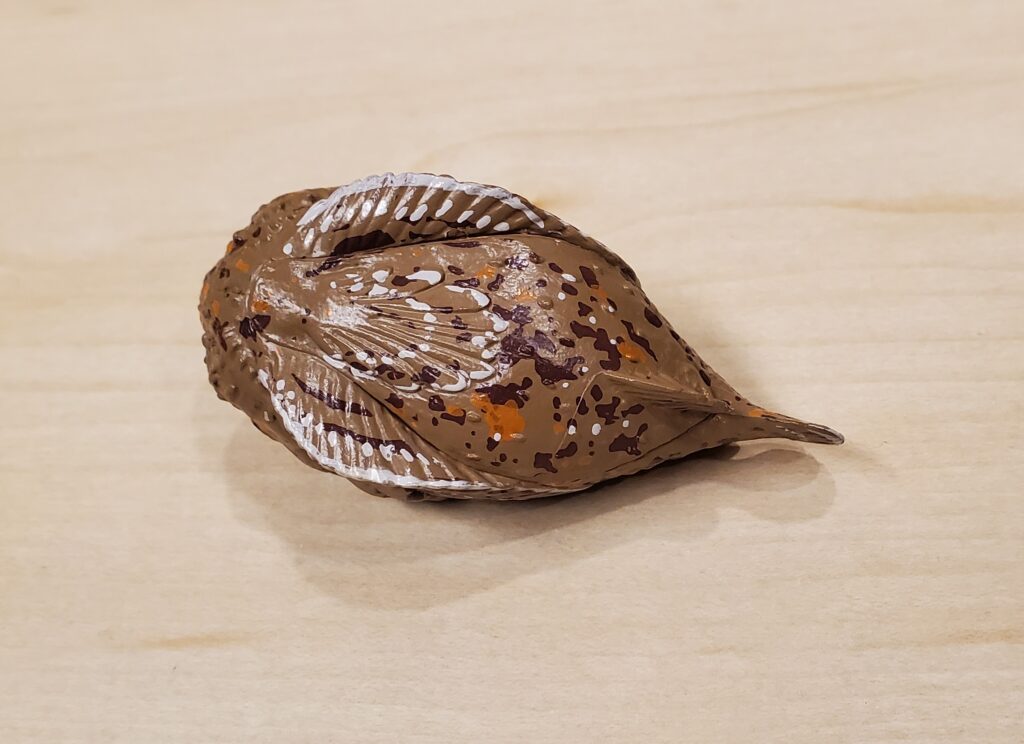

Box jellyfish. This was the figure I was most excited for! At first I assumed it was the infamous Australian box jelly (Chironex fleckeri) but the Japanese theme made me re-examine that identification. The text on the box specifically mentions its presence around the Okinawa Islands, suggesting an identification of Chironex yamaguchii, commonly known as habu-kurage in Japan (which translates to viper jellyfish). This isn’t our only figure of an Asian box jellyfish; in 2021 Kaiyodo produced a figure of Carybdea brevipedalia. Like its Australian counterpart, C. yamaguchii is very deadly and can cause cardiac arrest and respiratory failure with pulmonary edema. The entire figure is approximately 8.5 cm in height. The bell height is approximately 2.0 cm for a scale of 1:3-1:5.5. The bell is a clear, hard plastic but the tentacles coming off of the pedalia are soft and rubbery, much like the Kitan Club/Ikimon jellyfish. There is a little receptacle under the bell (perhaps to display on the end of a pen or pencil?). The base used in my pic was borrowed from another figure and not part of this set.
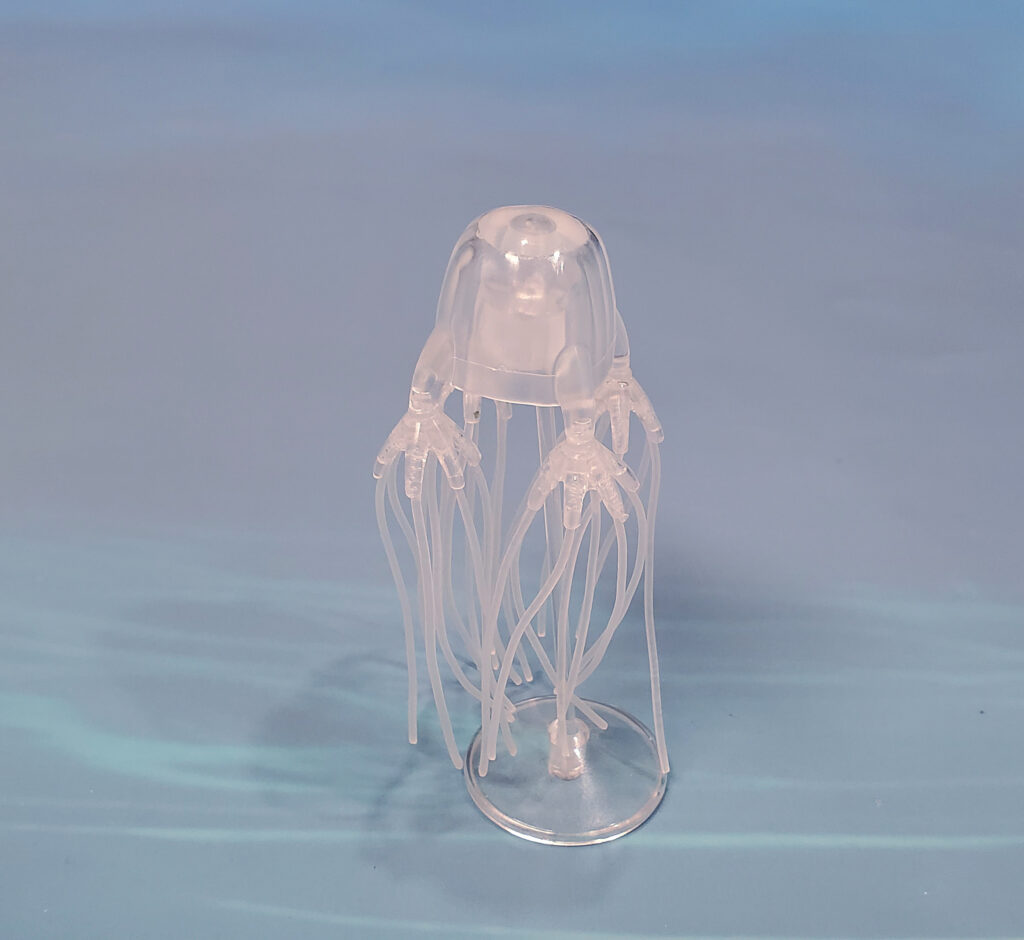

Overall, this set comes very highly recommended to general collectors, collectors of marine life, and collectors of unusual taxa. It offers a wide variety of interesting taxa, some of which are unique or have been rarely produced in the past. I am planning on holding onto the entire set, even for the figures that are not immediately going into the Mathison Museum of Natural History. They are a good size as to not take up too much space and are made of a firm, high-quality plastic. Access figures can be very difficult to track down, and Japanese eBay, Yahoo!, and other auction sites might be the best options.
Disclaimer: links to Ebay and Amazon on the AnimalToyBlog are affiliate links, so we make a small commission if you use them. Thanks for supporting us!




Cool set! I like the stonefish, crab, and jelly the most but they’re all excellent. Even the tiger shark is decent, but a bit too small for me. Not something I’ll likely track down, being Japanese, but I still enjoyed reading the review.
If the tiger shark had been a little bit bigger, I was tempted to replace the WS version I have. But then it becomes a coin toss over which inaccuracies are more tolerable. Safari has the incorrect number of gill slits, but a correctly-shaped tail, whereas this Access tiger shark as the correct number of gill slits but the tail is too simple. The Safari figure probably would have won out in the end, but it was a tempting thought to replace it.